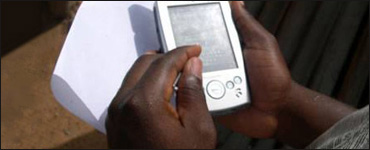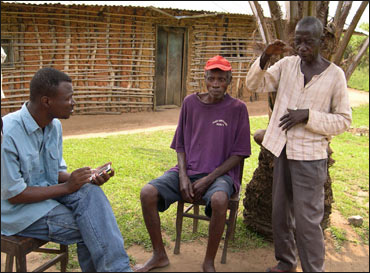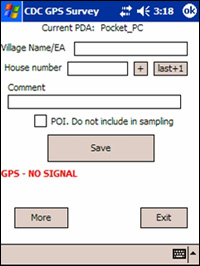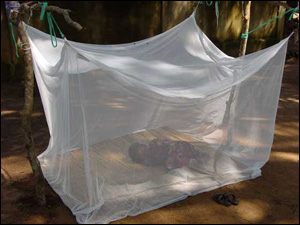CDC Features
From Paper to PDA: Public Health Data Collection

Photo by courtesy of Allen Hightower
Every day, two teams of about 40 Kenya public health staff fan out throughout the Nairobi shantytown of Kibera and a rural area known as Asembo, looking for people with pneumonia, diarrheal disease, and febrile illness. There they collect syndrome data from 55,000 people. Their secret weapon in this daunting task is their personal digital assistants, or PDAs, which they use instead of the classic clipboard to collect data. Within hours of their return to a computer center, the data is downloaded and aggregated, and is available the next day.
 A field worker in Kenya surveys the population using a PDA. Photo by courtesy of Allen Hightower
A field worker in Kenya surveys the population using a PDA. Photo by courtesy of Allen Hightower
The project saves millions of pieces of paper a year. And it may have been impossible without the help of the PDA technology, says Allen Hightower, MS, associate director for informatics at CDC Kenya. "How would you collect data on 55,000 people and process it every two weeks in a timely manner? You'd get swamped."
The use of PDAs is just one example of how new technologies are advancing public health. The continued spread of these technologies, however, will be advanced greatly if health information systems are standardized and modernized across the world. This is the goal of the Health Metrics Network (HMN), a global partnership in which CDC is a key technical advisor.
The HMN is a public-private partnership led by a Secretariat hosted by and housed at the World Health Organization in Geneva. Its biggest source of funding is an initial $50 million, seven-year grant from the Bill and Melinda Gates Foundation, with additional contributions by USAID and the British and Danish international aid agencies.
The primary goal of HMN is to create a harmonized framework for national health information system development including standards for health information systems. The HMN also provides support to selected low- and middle-income countries of up to $500,000 a year for modernization of their health information systems.
A System-wide Approach

PDA view of CDC GPS Survey data collection screen. Photo by courtesy of Allen Hightower
Global health initiatives have typically focused on specific diseases such as HIV/AIDS, malaria or pandemic influenza, explains Michael St. Louis, MD, Acting Director, Division of Global Preparedness & Program Coordination, COGH (Capt. USPHS). "But there is a recognition that the capacity of countries to actually respond to these diseases depends not only on disease-specific responses but on the overall health systems they're working with."
Today, too much health information is entombed in stacks of paper that may never be used to benefit patients or as part of a public health assessment. Modernization of health information systems will allow public health agencies to spot public health problems earlier, portray them more accurately, and respond more appropriately, St. Louis says.
PDA Use in Thailand
For example, CDC in Thailand has been using hand-held PCs in the field since 2001, starting with behavioral and HIV surveys with youth and gay/men-who-have-sex-with-men populations, says Philip Mock, MA, team lead for IT and informatics at CDC Thailand. The PDAs are appealing to students who are intrigued by technology, so they are more motivated to fill out the surveys, Mock says.
In some cases the interviewer hands out several PDAs—to a classroom, for example—and respondents self-administer the surveys, Mock says. This affords the subjects privacy in their responses. "Research has shown that subjects who are using computers are often more truthful in answering sensitive questions," Mock says.
Handheld technology also allowed CDC to quickly develop a data collection tool for use in a post-traumatic stress survey carried out among the survivors of the deadly tsunami of December 2004 in three provinces of Thailand. Because handhelds minimize the requirements of data management, Mock said, they allowed for quick analysis and dissemination of the findings.
 Child in Kenya sleeps in a malaria bed net. Photo by courtesy of Allen Hightower.
Child in Kenya sleeps in a malaria bed net. Photo by courtesy of Allen Hightower.
CDC Kenya: GPS Equipped PDAs Help
Monitor Distribution of Malaria Nets
CDC Kenya used PDAs to sample about 2,000 rural households following the distribution of malaria bed nets. The survey team used PDAs equipped with a GPS mapping system. Surveyors could construct a map of most villages in less than four hours. The mapping software then chose a random sample and then guided the surveyors to the chosen houses using a virtual compass.
Use of the PDAs has big dividends in quality control, Hightower says. For example, the software instantly flags unusual responses and asks the surveyor to make sure that the data is correct. And the GPS system allows an unprecedented level of supervision of the survey team, as supervisors can track when and where surveyors move.
In the past, compilation of survey data has required hiring a small army of people to do data entry. In this case, data was available within one to two days after the survey.
Mobile Phone Reporting and Delivery of Health Messages
Mobile phones are another important device for collecting and distributing public health information in areas where landlines and even electricity may be scarce. These phones can function like computer networks in areas where Internet access may still be years away.
In Rwanda, CDC is supporting deployment of an information system that uses cell phones and the Internet for data entry and reporting on HIV/AIDS. When it is fully deployed, physicians at clinics without electricity or telephone lines will be able to receive lab test results and treatment guidelines by cell phone, allowing them to better tailor therapy.
The Health Metrics Network is not the only organization that is working to modernize health information systems. But thanks to new standards being developed by the network, more developing countries may soon be able to take advantage of new technologies that may allow them to catch up to—and even "leapfrog"—richer countries in their information reporting and distribution.
For more information on the Health Metrics Network, visit www.healthmetrics.org.
Originally published in CDC Connects, CDC's employee publication
Page last updated: June 12, 2007
Content Source: CDC Office of Enterprise Communication
Content owner: National Center for Health Marketing
URL for this page: www.cdc.gov/Features/phPDA


